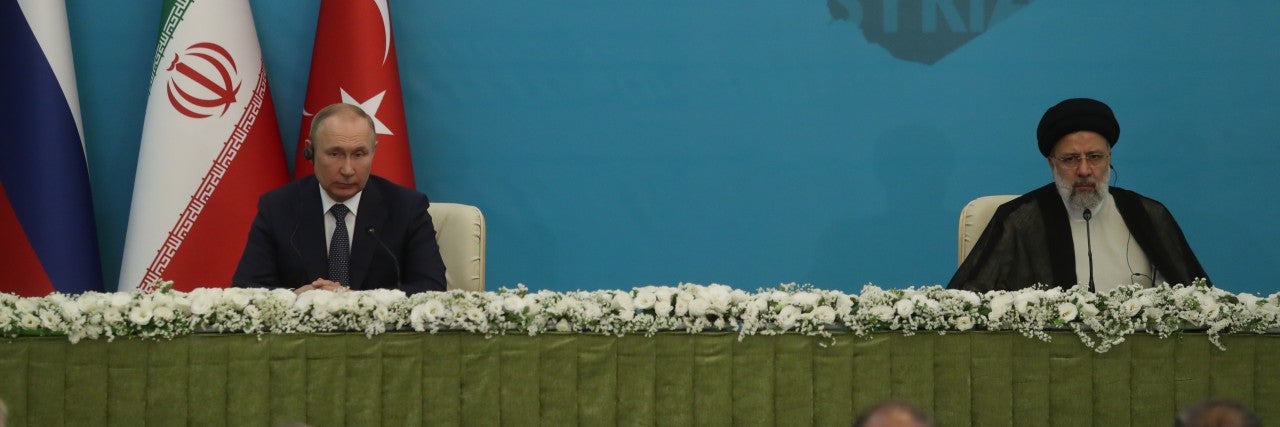November 28, 2022
Iran and Russia have reportedly reached a deal to begin manufacturing hundreds of attack drones in Russia.
The latest deal represents a further deepening of the Russia-Iran alliance that has enabled Russia to launch hundreds of Iranian-made drones against Ukraine since August, with many targeting civilian infrastructures that provide power and water to millions.
This purported deal comes as Russia is facing significant setbacks in its war in Ukraine in the east and south, including its pullback from the critical southern Ukrainian city of Kherson in recent weeks.
Russia can now dramatically deepen its stockpile of inexpensive but highly destructive weapons. At the same time, this deal will provide further financial and political support for the embattled Iranian regime, which is facing massive anti-government protests and increasing sanctions.
White House National Security Council spokesperson Adrienne Watson said that “Tehran is helping kill Ukrainian civilians through the provision of weapons and assisting Russia in its operations. It’s another sign of how isolated both Iran and Russia are.”
“The United States – with allies and partners – is pursuing all means to expose, deter, and confront Iran’s provision of these munitions and Russia’s use of them against the Ukrainian people. We will continue to provide Ukraine with the critical security assistance it needs to defend itself, including air defense systems,” Watson said in the statement.
Here is why the deepening Russia-Iran alliance is a major concern for Western allies and the Middle East.
- Iran has battle-tested drone technology
Over the years Iran has expanded its influence in the Middle East, through its role in supporting terror groups in Lebanon, Syria, Iraq, and Yemen. One key method of exporting its influence has been the development of drone technology.
According to a 2019 U.S. Defense Intelligence Agency assessment of Iran’s military capabilities, “UAVs are Iran’s most rapidly advancing air capability.”
“Iran has steadily expanded its domestic UAV inventory by developing and producing a wide range of lethal and nonlethal UAV platforms. Iran has reverse-engineered many of these systems based on captured Western UAVs,” the report stated.
Iran and its terror proxies have used drones in several different arenas in the Middle East, including in Iraq, Syria, Israel, Saudi Arabia, and the UAE. It has also targeted oil tankers in the Gulf of Oman.
Particularly troubling has been Iran’s rapid advancement of its drone capabilities in recent years.
According to a report by United Against Nuclear Iran, a think tank, Iran has accelerated its efforts to develop its UAV systems and transform its drones “into versatile platforms with integrated or suicide attack capabilities.”
- Iranian danger to Europe
While Iran has long posed an acute risk to the Middle East, through its support for terrorism, ballistic missile program, and nuclear activities, Europeans have not viewed Iran’s malign activities with the same urgency as Israel and nearby Arab states.
According to Daniel Schwammenthal, director of AJC Transatlantic Institute, the West has not learned its lesson in confronting its enemies, especially Iran.
"If the West's conclusion from Russia's invasion of Ukraine is to confront only Moscow while continuing to engage our other enemies in the futile hope to mollify their behavior, then I'm afraid we haven't learned our lesson,” he said.
“As Iran's plans to sell drones to Russia for Moscow's war against Ukraine demonstrate, we must believe and tackle all our enemies. We must acknowledge that engaging Tehran has so far failed, just as engaging Moscow has failed in the past,” he said, referring to Western efforts with Russian President Vladimir Putin.
Schwammenthal added that increased cooperation between Iran and Russia is a signal to Europe and the West that they must be equally united in confronting them.
“Iran is not just a threat for the Middle East, but as this drone sale shows also for Europe and the West at large. This development underlines the need for Europe, the U.S., Israel, and our other allies in the region, to close ranks against the rising threat from Iran.”
- Threatening Middle East stability
Under President Vladimir Putin, Russia has sought to increase its historic presence in the Middle East. Russia has a longstanding naval base in Syria, which it inherited from the Soviet Union, and sent troops to Syria as part of the effort to aid the Syrian government in its bloody civil war.
Beyond the destabilizing influence it has played in Syria, Russia has also looked to expand its presence in other Middle Eastern countries such as Libya and Egypt.
President Biden’s July 2022 trip to Israel and Saudi Arabia was, among other objectives, part of an effort to counter the increasing overtures by Russia and China to the Saudis, especially as Russia seeks to keep oil prices high to fund its war in Ukraine and keep pressure on Western nations suffering from high gas prices.
Russia’s inroads in the Middle East also pose a potential security challenge to Israel. During the course of the Syrian civil war, Israeli and Russian militaries have had a deconfliction mechanism, in which Israel notifies Russia of any military operations in Syria that could pose a risk to Russian forces. In turn, Russia has let Israel operate within Syria to target Iran and its terror proxies without interference.
However, Russia has become more critical of Israeli airstrikes in Syria, and has called on Israel to cease its attacks. Israel regularly targets Iranian and Iranian-backed terror groups in Syria that pose an increasing threat to the Jewish state.
- Bolstering Russia’s capabilities in Ukraine
For decades, Russia has been seen as a weapons exporter. Yet, reports indicate that Russia has been depleting its weapons arsenal as the war continues and Ukraine is being bolstered by advanced Western weaponry, including the HIMARS system, an armored-vehicle-mounted long-range artillery launcher that has enabled Ukrainian forces to hit Russian targets dozens of miles away with precision.
AJC has advocated for the U.S. to take several measures to support Ukraine and isolate Russia, including providing critical military aid to the besieged nation. Speaking to AJC Global Forum 2022, Ukrainian President Volodymyr Zelensky thanked AJC for its “substantive help” and called on supporters to redouble their efforts to stop Russia.
To counter this, it appears Russia is leaning on rogue states such as Iran, with which the country has a longstanding relationship, especially in the Syrian civil war, to replenish its drone arsenal.
A U.K. Ministry of Defence intelligence report said that Russia has suffered a high attrition rate of its drones, in particular its reconnaissance UAVs.
“Russia has attempted to implement the concept of ‘Reconnaissance Strike’ it refined in Syria, which uses reconnaissance UAVs to identify targets to be struck by combat jets or artillery,” the intelligence report said.
It added that if Russia continued to lose UAVs, “Russian forces intelligence, surveillance, and reconnaissance capability will be further degraded,” and this would “negatively” affect their ability to fight.
CIA Director William Burns said that Russia’s interest in buying Iranian drones reflects the poor state of its military.
“It’s true that the Russians are reaching out to the Iranians to try to acquire armed drones,” he said, Bloomberg News reported.
“They need each other, they don’t really trust each other, in the sense that they’re energy rivals and historical competitors,” Burns said, adding that the deal is a reflection “of the deficiencies of Russia’s defense industry today, and the difficulties they’re having after significant losses so far in the war against Ukraine.”
Western allies have been firm that Iran’s provision of drones to Russia is a violation of UN Security Council Resolution 2231, which, among other restrictions, prohibits transfers of weapons and ballistic missiles to and from Iran.





